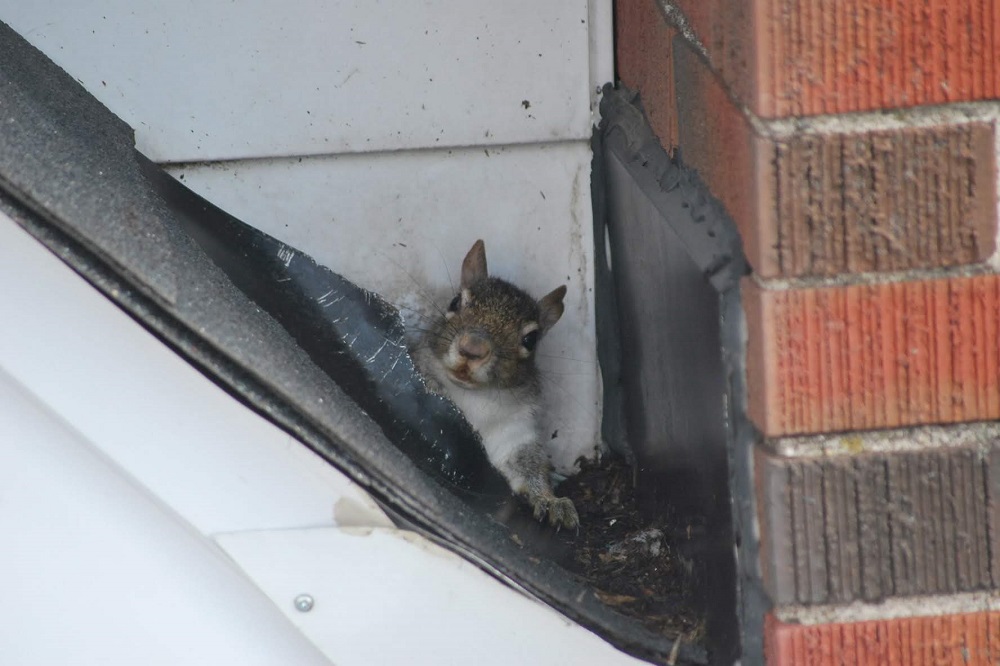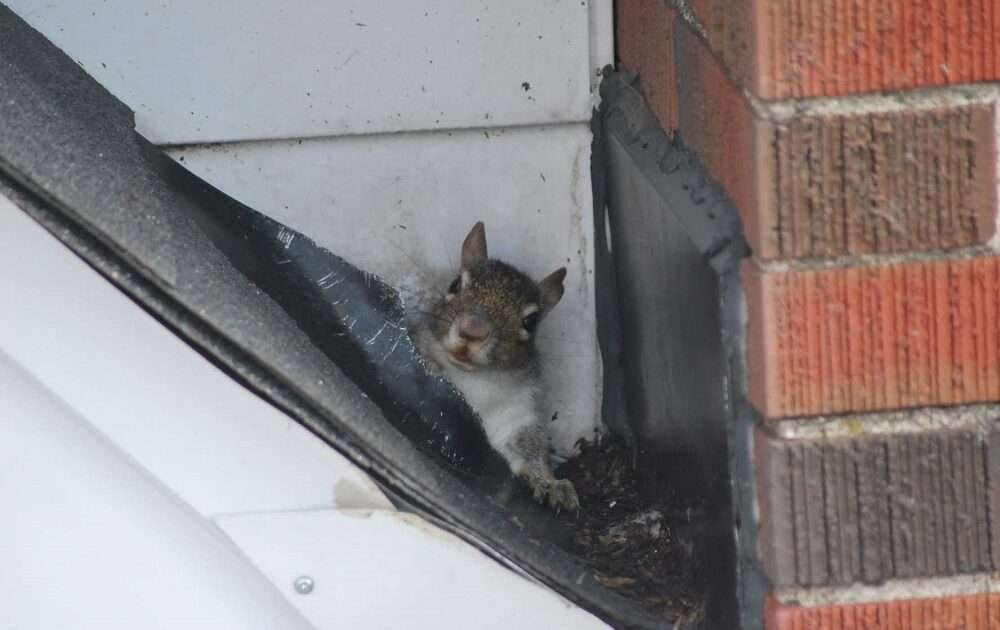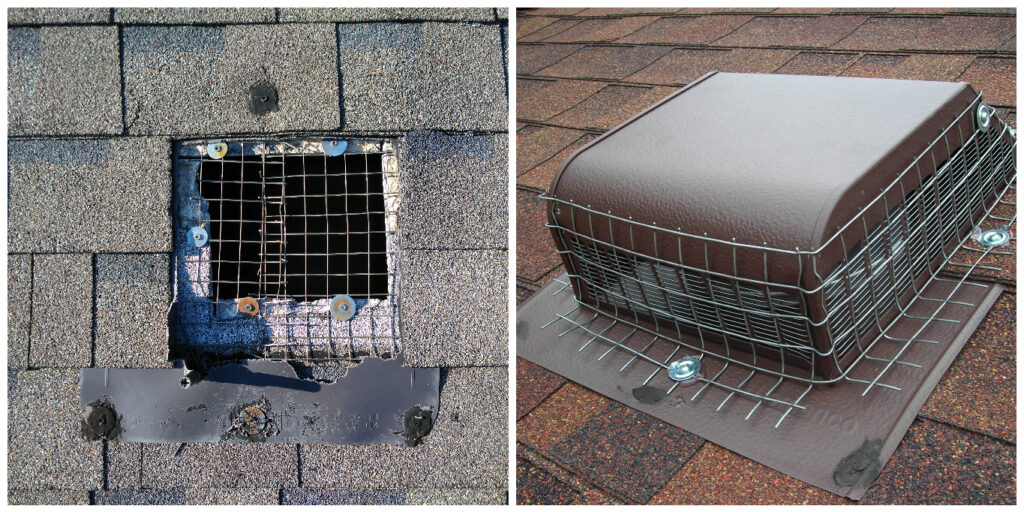Whether you love them and think that they are cute and cuddly or dislike them and think they are just a nuisance, there is no denying that squirrels are fascinating animals. They are agile, intelligent and adaptable and that makes them good home invaders.
At Skedaddle we understand animal behaviour and know that we need to think ahead to effectively keep squirrels from making themselves at home in your home. Our years of experience have taught us a few valuable lessons about how squirrels access properties and how best to keep them out and we use this knowledge to secure and protect our client’s homes from wildlife invasions.
Unfortunately, there are several weak points on most houses that squirrels can exploit to gain entry into a home. Some of these are construction or maintenance issues. For example, not all soffits are fitted flush with the siding on the walls and if the soffit is not installed properly, there is often a small space that a squirrel can squeeze through. Damaged or missing materials also creates potential entry points for all sorts of wildlife. A squirrel only needs a hole that is two inches in size to get into your attic and roof edges that are not properly maintained will deteriorate over time. Older homes will often develop holes along the edges of the roof, providing easy access for squirrels, but one of their favourite entry points is the vent.
Roof and gable vents allow air to circulate through your attic, but broken vents are like an open door for squirrels and other wildlife. However, the vent covers don’t even need to be broken for vents to be potential entry points for squirrels. Roof vents are typically made from wood, aluminum or plastic. And at Skedaddle we see time and again how easily squirrels gnaw through these materials. The same applies to exhaust vents in kitchens, bathrooms, and laundry rooms. The vent pipe resembles a tree cavity, making it the perfect place for a squirrel to build a nest.
Why don’t you screen roof vents from the inside?

This is a frequent question from our customers. We know that the screens are not always the most aesthetically pleasing objects and many customers would prefer us to put vent screens on the inside of the roof vents so that they are not visible. Sometimes, however, being practical and functional is more important than the aesthetic considerations.
The simple answer to why we put roof vent covers on the outside is because placing the cover on the inside would defeat the purpose of the exercise. Roof vents are made from plastic or thin aluminum, material that is no match for the strong jaws of a squirrel or the dexterous paws of a raccoon. Placing the roof vent cover on the inside would not protect the vent cover and it would still be vulnerable to tampering by wildlife. Once a squirrel or raccoon has ripped open the vent cover, they may not be able to bypass the screen but they would have already made a mess and they will leave a gaping hole where rain and snow can get in and cause major damage to your property.
Getting it done right the first time
Unfortunately, at Skedaddle we all too often see the mistakes that contractors make when installing vent screens and we are called in to fix the damage. Our Wildlife Technician, Ben, was recently called to the home of a customer to help solve her squirrel problem. The costly part of this story is that Skedaddle was not her first call.
When the customer had initially discovered that she had an invasive squirrel problem, she had called in a wildlife control expert to deal with the issue and secure her home from future invasions. She had paid the wildlife prevention and control company to place screens on her roof vents and the company had assured her that they had replaced all the damaged vents and installed screens. So why did she still have a squirrel problem? When Ben climbed up onto the roof to do an inspection, the answer was obvious. A squirrel had chewed through the new roof vent and left a gaping hole. When Ben took a closer look, he saw that the company had placed the screen underneath the vent rather than completely around it. Not an effective strategy for squirrel control.
Many of our competitors and home improvement DIYers screen vents from the inside because it looks more appealing, or the roof is either very steep or they do not want to climb up on the roof and it is easier to access the vent from inside your attic. But this is not going to solve your problem. At Skedaddle we know that screening around the vent from the outside is the only way that we are going to be able to effectively secure the entire area that could be accessed by squirrels and other invasive wildlife. Our way saves you time and money and gives you the peace of mind of knowing that the job has been done properly.
Unfortunately for this customer, she left her roof in the wrong hands and it cost her. She ended up paying twice for the same job. Yes, the screen on the inside had stopped the squirrels from entering her home, but they had done excessive damage to her roof vent and the vent had to be replaced. To add insult to injury, the customer’s house had suffered weather damage from rain entering the roof through the broken vent.
Why do squirrels find our attics so attractive?
Why do squirrels try so hard to gain access to our attics, surely there are easier and more accessible places for them to build nests? Ideally, squirrels should be living in densely forested areas with a high concentration of trees like oaks, walnuts and pines and a thick canopy that keeps them safe from predators and allows them to move, nest and forage above ground. Sadly, this type of habitat is not always available, but squirrels have adapted well to living alongside humans. As human development has destroyed their natural habitat, squirrels have altered their habits to survive in our habitat. Squirrels use telephone wires, powerlines and rooftops to stay above their predators and instead of making nests in tree cavities, they move into our attics. Attics make ideal nesting sites for squirrels because they are high above the ground, safe from predators, and warm and dry throughout the winter, protecting the squirrels from rain, snow, and inclement weather.
Once inside your attic squirrels can create a lot of mess and do substantial damage. They can gnaw through your insulation and electrical wires, creating a potential fire hazard. If you suspect that you have squirrels in your attic or that they have been destroying your roof vents you need to call a professional wildlife control expert immediately. Skedaddle Humane Wildlife Control will be able to help you with all your squirrel related problems and we will secure your home from future invasions.





